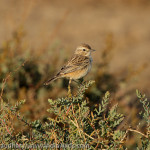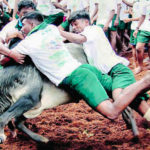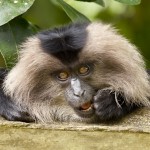Wild Cats of the World
By: Mel Sunquist and Fiona Sunquist
Do you know what is Jaguarundi? Have you ever heard about Oncilla, Kodkod and Manul? These and other species of wild felids totalling 36 have been covered in the book Wild Cats of the World.
This book has detailed the ecology and behaviour, social organisation, feeding ecology, distribution of the species, reproductory behaviour, status in wild as well as in captivity for each of the listed species. The book also contains lot of photographs both in colour as well as in black and white. Many of those are from captivity. Though some of the photographs could have been better, still they help in conveying the information of the species. I liked the way each chapter on a species starts with a black and white photo.
Leopard Behaviour:
The compilation by Mel Sunquist and Fiona Sunquist would also appeal to the casual wildlife lover as the chapters have many interesting references about the behaviour of a species which would challenge the knowledge gleaned by watching some of the wildlife programs of the popular broadcasters like NGC and Discovery. For example, it is a generally accepted fact that a hyaena appropriates the kills of a leopard and the leopard generally leaves the kill and takes cover. However, one incident from the book shows the opposite. Jonathan Scott records an occasion when a female leopard struggled with a hyaena that was attempting to steal a kill from her. “She charged, switching from defence to attack, clawing at the hyaena and sinking her daggerlike canines into his neck as he attempted to snatch the impala away….The two animals continued to struggle ferociously for possession of the impala, fighting in the manner of hungry lions contesting ownership of a small kill. Neither dared release their grip on the food so as to bite the other, for fear of losing it altogether. The hyaena outweighed Chui by at least thirty pounds, and the crushing power of his jaws was second to none. But it was Chui’s food and she possessed the muscular strength which, pound for pound, rivalled that of any hyaena. The leopard wrenched the kill and the hyaena towards the euclea tree where the impala had originally hung”. (page 328)
Domestication of Cats:
Dogs are generally referred to as man’s most loyal companion and hence one may guess that there would be more dogs than cats. However, this book dispels that myth and says that in 1997 there were 70.2 million pet cats in USA as opposed to 55.9 million dogs.
It also provides information about origin and domestication of cats. “cats are believed to have been first domesticated in Egypt, some four thousand years ago, but the problem of identifying the exact period when domestication occurred is complicated by the fact that domestic cats are only recently descended from the African wildcat (Felis silvestris lybica). For this reason, the skeletons of domestic cats and wildcats are difficult to differentiate”… “Though most of the evidence points to Egypt as the birthplace of the domestic cat, bones of small felids have been found at older archaeological sites in other areas. The remains of African wildcats have been excavated from Jericho and dated at 6000 to 7000 B.C., but there is no evidence that these were from domesticated animals; rather, they may have been the bones of cats killed for fur. Recent excavations of a six-thousand year old settlement on the Mediterranean island of Cyprus have unearthed a cat’s jawbone, suggesting that cats may have been associated with people for longer than was previously thought. Wildcats do not occur naturally on Cyprus, so the animal on the island must have been brought there in a boat, either as an accidental stowaway or as a pet”. (page 100)
Information about Early Lions
“The earliest true lions appeared in Europe 600,000 years ago. Believed to be the largest cats that ever lived, these early cave lions were some 25 percent larger than today’s largest lions. The European cave lion (Panthera leo spelaea) spread from Europe to eastern Asia, and fossil material about 400,000 years old has been found at China’s Peking Man site in Choukoutien, where fossil tigers have also been found. Cave paintings and fossil evidence from 200,000 years ago show that cave lions later coexisted with early humans-lion bones have been found alongside artifacts from Neanderthal people”. (page 286)
Lion vis-a-vis Tiger:
There is an interesting information about fighting ability of a lion vis-à-vis a tiger. “Occasionally lions were forced to fight tigers, but apparently the tiger always won. This observation was confirmed more recently in the 1950s by a keeper at the Bronx Zoo, where a lion cub named Zambezi and a young tiger named Ranee were raised together. Their occasional fights always resulted in victory for the tiger. Alfred Martini, the keeper, described the tiger as being a better fighter, “like clever boxer against a heavy hitter, shrewder and trickier”. (page 287)
Apart from the species listings there are also other interesting chapters. In the Appendix, chapters like Olfactory Communication in Felids, Vocal Communication in Felids, Reproduction in Felids etc as well as Conservation status that are informative. One can also find the list of Scientific as well as Common names of the species for ready reference.
Though this book claims to be the ultimate reference to every species worldwide and the authors are said to have put in more than a decade of work there are certain areas that could have benefitted some rigorous effort.
There are also chapters on field research techniques, Relocating Cats: History and Guidelines for Future where the authors briefly cover the subject, the researchers as well as serious wildlife lovers can get much more detailed information from other sources. In the Relocation Cats chapter one would have expected the introduction of a zoo bred tigress into the wild by Bill Arjan Singh, as the authors seem to be familiar with Billy, having quoted him in the leopard chapter. Similarly introduction by Born Free foundation which had got lot of press coverage worldwide or relocation of lions from Gir to Chandraprabha Sanctuary in Varanasi Forest Division in 1965 should have found mentions as they were some of the initial work done on the subject. In India a lot of work has been done on relocation of leopards as well as tigers since the publication of the book “Wild Cats of the World”. So readers of the book may skim through these chapters.
The authors have quoted scientific journals, papers etc and have even cross-referenced those. However while including references some of the popular and respected authors like Jim Corbett and Billy Arjan Singh are included but well respected naturalists like M. Krishnan’s observations are surprisingly absent. Even authors like Kenneth Anderson have been quoted whom Billy Arjan Singh had accused of concocting “pot-boilers” stories in his books. The authors perhaps have depended on books published abroad and/or of foreigners. Many Indian authors especially on tigers have been completely overlooked. Hopefully these can be taken care off in a next edition or by other authors if and when such a work is again undertaken.
In the wild cats category the information on Indian desert cat Felis libyca is sparse.
To conclude, I feel “Wild Cats of the World” with its 452 pages will be a good help to researchers for preliminary help on literature survey as the articles are cross-referenced. It will also be a good reading for kids, students and wildlife enthusiasts for the breadth of information. The book is hard bound and is published by University of Chicago Press.
The list price of the book is $45 USD. It is available in India at Rs.3409/- from amazon.in
One can also find this book now in Amazon India at the following link:
- GoPro Hero 12 Black - 6 September,2023
- Leopards: The Last Stand - 2 July,2023
- Drifting in the Waters of Sundarbans - 26 March,2023














Gorgeous feline beauties. I had the opportunity to see all three lions, tigers and leopards closely at Gir.